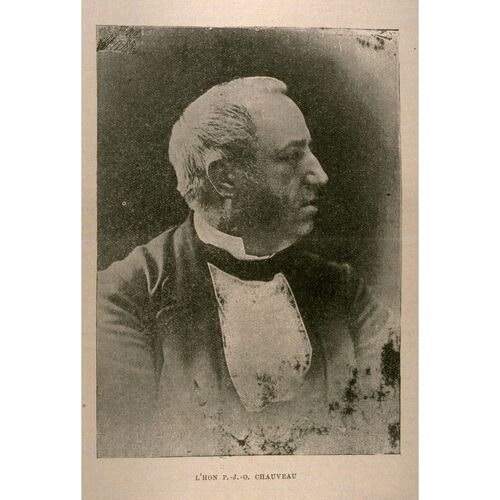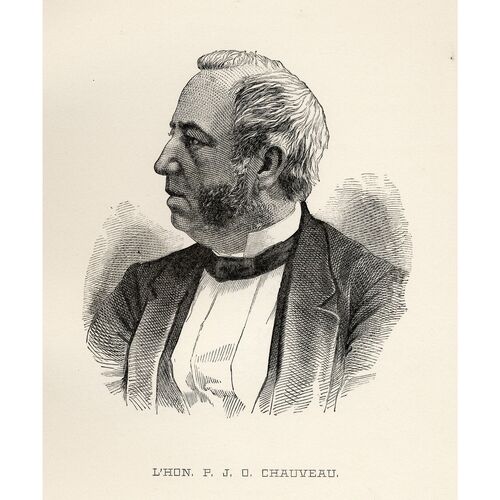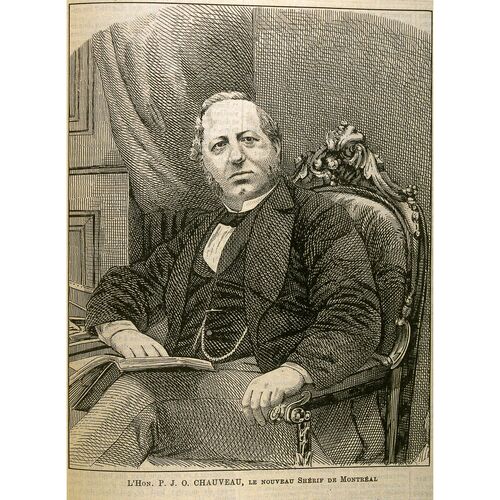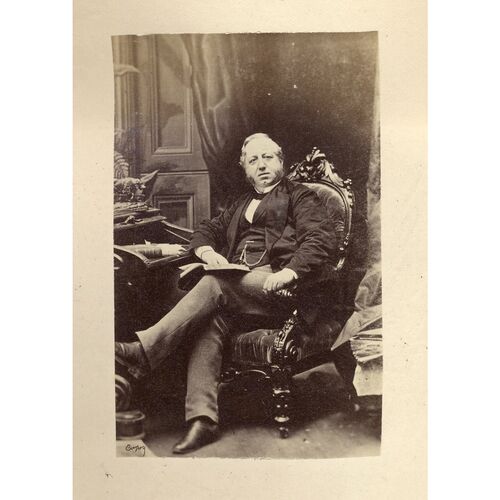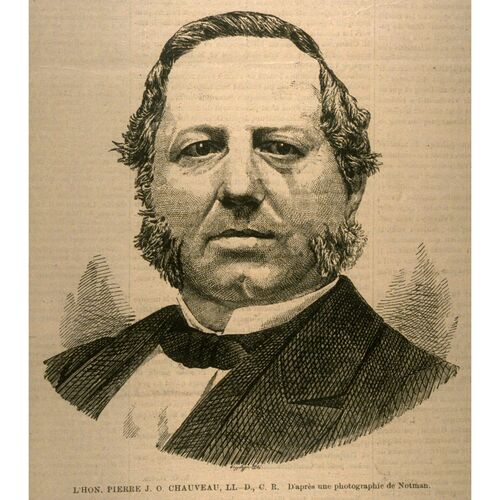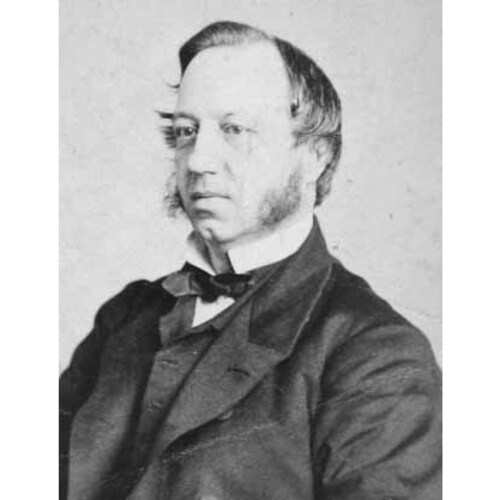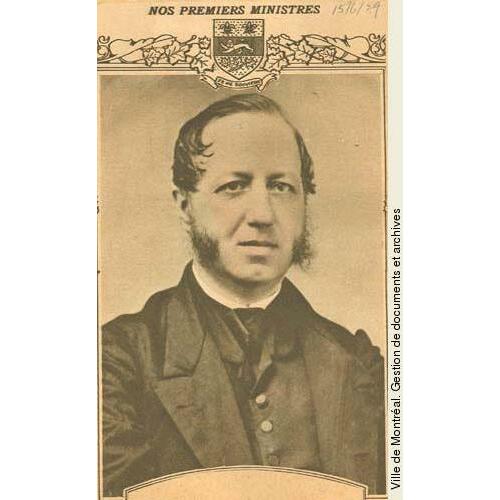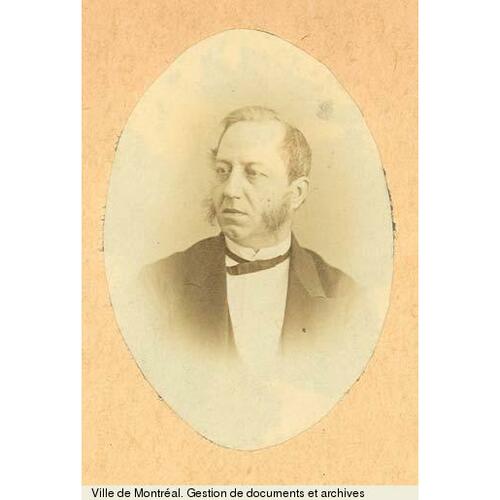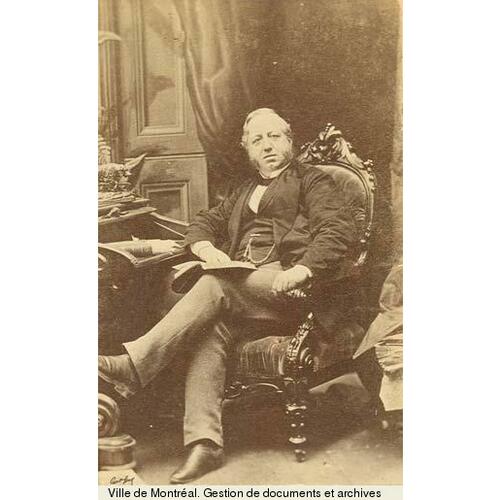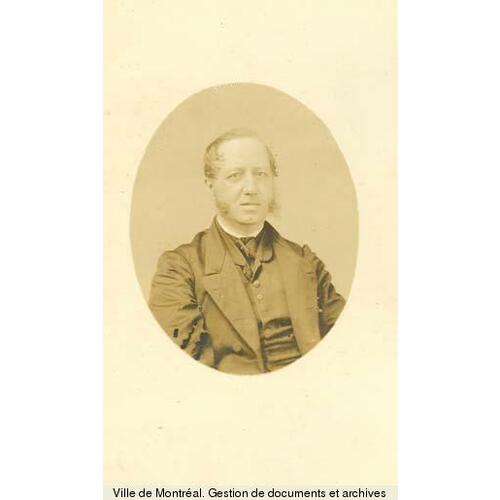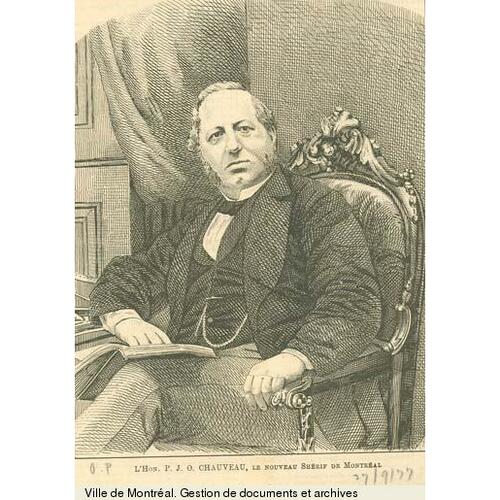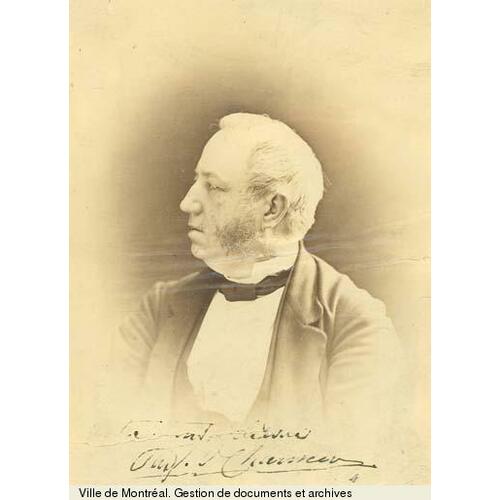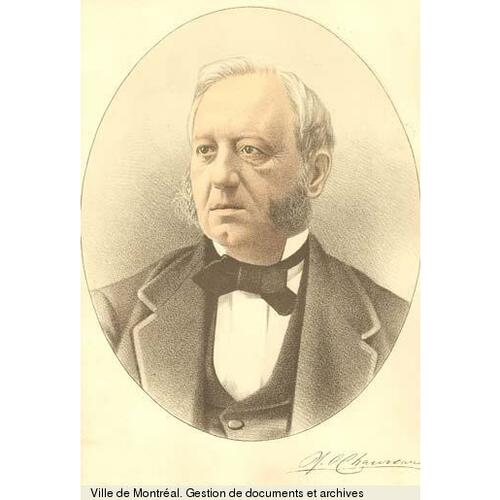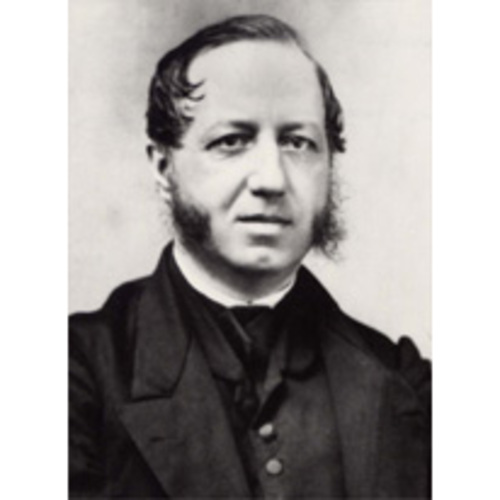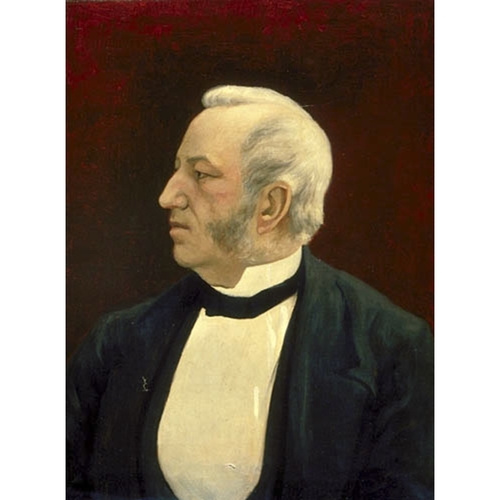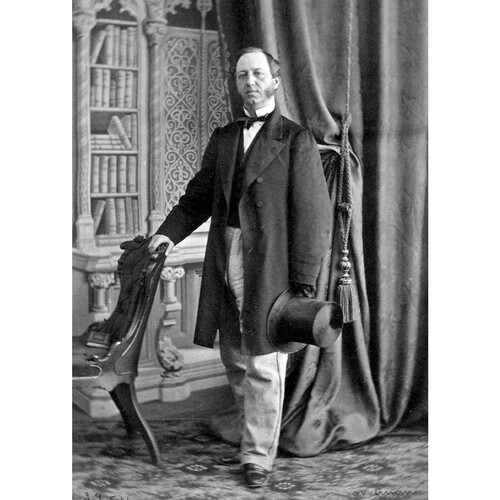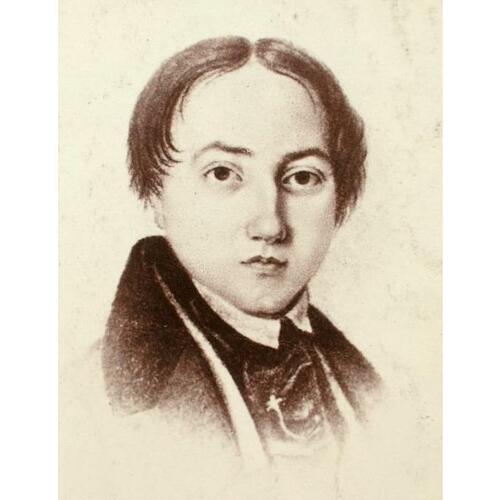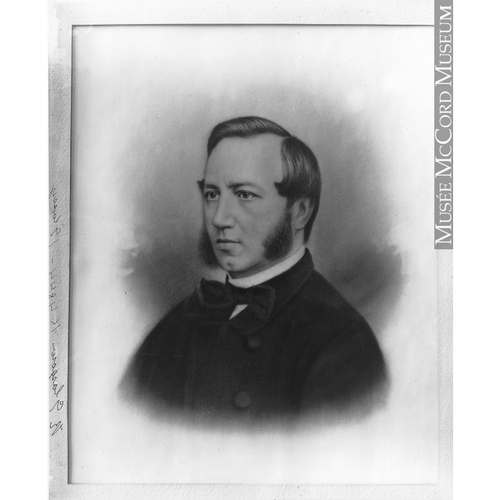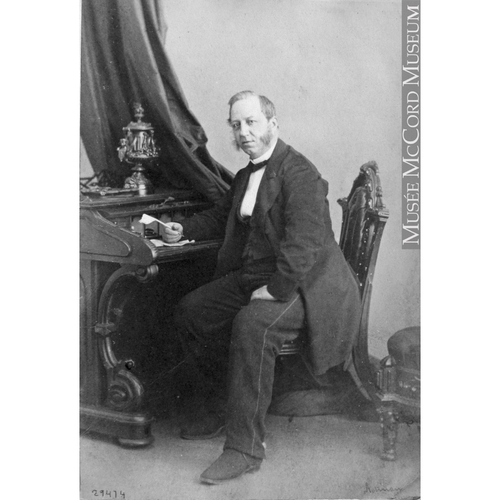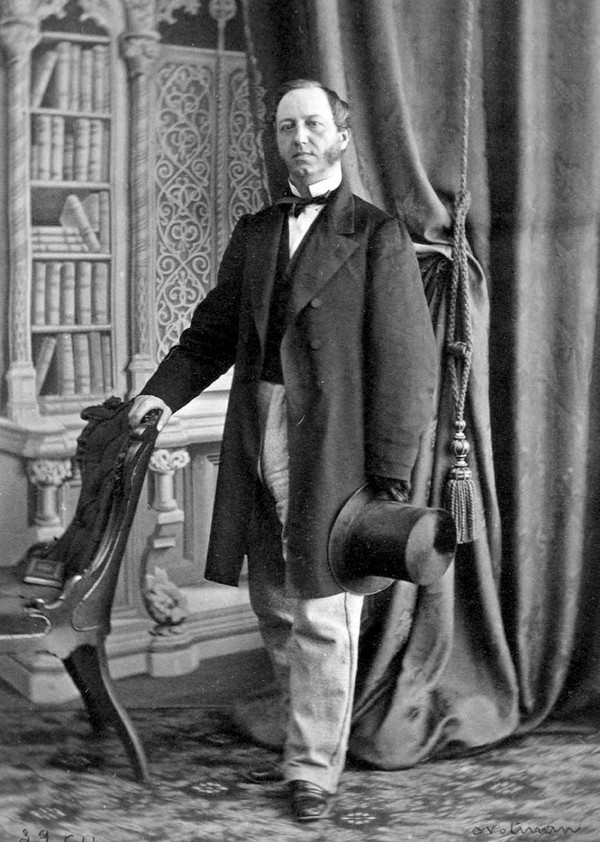
Source: Courtesy of Wikimedia Commons
CHAUVEAU, PIERRE-JOSEPH-OLIVIER, lawyer, man of letters, politician, sheriff, and professor; b. 30 May 1820 at Charlesbourg, Lower Canada, son of Pierre-Charles Chauveau and Marie-Louise Roy; m. 22 Sept. 1840 Marie-Louise-Flore Masse at Quebec; d. there 4 April 1890.
The Chauveau family was one of the oldest in Charlesbourg. Pierre, a cooper from Bordeaux, France, had settled there at the beginning of the 18th century. On 22 Aug. 1707, at Beauport, he married Marie-Charlotte Lavallée, and they had 12 children. Pierre-Joseph-Olivier was of the fifth generation of Chauveaus in Canada. He scarcely remembered his father, a prosperous merchant of Charlesbourg, who had died prematurely when Pierre-Joseph-Olivier was only four. His maternal grandfather, Joseph Roy, a rich grain merchant who lived at the corner of Rue Sainte-Anne and Rue du Trésor in Quebec City, assumed the father’s responsibilities, taking his daughter and her small son into his home. According to one of his biographers, Louis-Michel Darveau*, Chauveau enjoyed an “extremely pampered” existence in this household, for attention was lavished on him by his mother, two aunts, and grandfather. Darveau thinks this hot-house atmosphere fostered Chauveau’s desire to please and need to be flattered.
In Quebec Chauveau attended the primary school near the garden of the fort on the Plains of Abraham. At nine he entered the Séminaire de Québec, where he proved a brilliant pupil with obvious literary talent. Chauveau said little about these years, when his fellow students were Elzéar-Alexandre Taschereau*, later a cardinal, and Luc Letellier de Saint-Just, who became lieutenant governor of Quebec. Two teachers, the abbés Jean Holmes* and Jérôme Demers*, are thought to have kept an attentive eye on his progress.
At 17, after hesitating between law and the priesthood, Chauveau finally chose law. He articled in the law office of his two maternal uncles, André-Rémi Hamel*, the advocate general for Lower Canada, and Louis-David Roy*. He had much in common with Roy who, at 29, was a friend of François-Xavier Garneau* and, as Chauveau noted, was “in his [own] generation one of the men who had the greatest talent for and dedication to the sciences and arts.” Both were keenly affected by the tragic events which culminated in the collapse of the rebellions of 1837 and 1838, and Chauveau, full of fire and ambition, was determined not to remain on the sidelines. On 6 April 1838 Le Canadien published his first poem, “L’Insurrection,” which exalted the heroism of the Patriotes. He subsequently sent occasional articles to this newspaper, including the poem “Adieux à Sir John Colborne,” on 23 Oct. 1839, which again expressed his patriotic fervour. In the turmoil of this period, which he judged “cruel” and “hard to weather,” Chauveau still managed to continue his legal studies, finishing under George Okill Stuart, whose firm was reputed one of the best in Quebec City. There he improved his English, acquiring an exceptional mastery of the language. On 30 Aug. 1841 he was called to the bar.
Chauveau began to practise law with considerable backing. His uncle Louis-David Roy invited him to become a partner in his firm, replacing Roy’s brother-in-law, André-Rémi Hamel, who had been appointed a judge on 1 May 1839. This offer was especially attractive since Chauveau had married on 22 Sept. 1840 and could not afford the luxury of a prolonged wait for clients. He practised with his uncle until 24 Dec. 1849, when Roy too was appointed a judge. Chauveau then went into partnership with a young lawyer, Philippe-Baby Casgrain.
It was the practice of law that assured Chauveau of an income, but it was politics and literature that intrigued him. Like most young people of Quebec, he was against the proposed union of the Canadas, but rallied, with Augustin-Norbert Morin* and Thomas Cushing Aylwin*, to support the “Adresse aux électeurs de Terrebonne,” delivered by Louis-Hippolyte La Fontaine* on 28 Aug. 1840, which argued that union could under certain circumstances benefit French Canadians. For Chauveau, La Fontaine was, however, only a political leader. His intellectual mentors were Étienne Parent* and Morin, who to counteract the defeatism spreading through French-speaking circles constituted themselves “the initiators of the national and literary movement among young people”; in addition, Napoléon Aubin, the editor of Le Fantasque in Quebec, had acquired a strong hold upon the younger generation through his free and easy manner, humour, and liberalism. With Joseph-Charles Taché*, Télesphore Fournier*, and James Huston*, Chauveau frequented the learned and patriotic circles and societies of Quebec. These educated young men gathered regularly at the Hôtel de la Cité, the Hôtel de Tempérance, or the offices of Le Fantasque, to meet Aubin, their intellectual leader. Eager to foster literary and scientific movements, Chauveau helped found the Société Saint-Jean-Baptiste de Québec in 1842, and the Société Canadienne d’Études littéraires et scientifiques the following year. At their gatherings he found audiences for his first great speeches, such as the one he gave to the Société Saint-Jean-Baptiste in 1842 on liberal ideas, in which he took the opportunity to denounce absolutism and colonialism. His dynamic contribution to the intellectual life of the city gained him the presidency of the Literary and Historical Society of Quebec in 1843. Chauveau’s fame was beginning to spread beyond Quebec, since letters he had written were published by French journalist Théodore-Frédéric Gaillardet, owner of Le Courrier des États-Unis (New York), from 20 May 1841 and reprinted in Canadian newspapers. In these letters – which were to appear at irregular intervals until 1855 – Chauveau analysed the situation in Canada, usually in the context of British colonial policy. His tone was restrained and polite and his interpretations were often apt and always shrewd. In his early writings he outlined the problems of a colony dominated by a narrowly mercantilist mentality and immured in “its middle ages,” as demonstrated by the “growing influence” of the clergy, “the remarkable piety of the upper classes [and the] superstitions persisting among the people.” In ensuing months he refined his thinking and modified his outlook. At the height of the crisis occurring under Governor Sir Charles Theophilus Metcalfe* in 1844, Chauveau denounced in Le Courrier the impracticality of the confederation scheme advanced by Lord Durham [Lambton*]: England rejected the plan because she was afraid of promoting the independence of the colonies as did the colonials because they feared excessive centralization.
The young man who spoke with such authority in Le Courrier des États-Unis in 1844 was 24 years old. Married and living in the residence which had belonged to his grandfather Roy and which he would inherit in 1851, he earned his living in the court room and his laurels in patriotic and literary circles. Lively and witty, Chauveau liked to charm and to display his brilliance, and he enjoyed both good books and the company of intellectuals. He was fiery, but not aggressive. Chauveau had a well-stocked, even encyclopædic mind and a reliable memory. He had definite ideas on literature and history which he developed in 1847 in a lecture entitled “État de la littérature en France depuis la Révolution,” published in the third of the four volumes of Répertoire national, ou recueil de littérature, brought out in Montreal in 1848–50 by James Huston. From Abel-François Villemain, a specialist in comparative literature at the Sorbonne who greatly admired Mme de Staël, Chauveau took the concept of linking literary movements to social realities: “the literature of a people is its history; it is the whole body of the writings of its most distinguished citizens.” This sociological vision of literature was matched by a vision of history which was free of any idea of divine providence. He argued that history was the resultant of two forces, the first an inward one “of concentration . . . , which tends to draw towards a common centre the public power, wealth, knowledge,” and the other an outward one of expansion which “tends to spread and universalize all these things, to make them as far as possible common to all and equal for all.” Philosophically, Chauveau was a liberal imbued with the idea of progress, for whom the French revolution represented “one of the progressive developments of Christian societies,” and constitutional monarchy “order united to liberty.” But he was also a patriot who felt keenly his status as a colonized subject. In his poem “Adieux à Sir John Colborne” he wrote of the French Canadian people: “Alms and kicks, [it] accepts everything with a dejected air.” He took great pride in his French origins, was chauvinistically dedicated to his native town, and pondered the fate of the French Canadian people anxiously.
Chauveau’s political opinions placed him with La Fontaine, although he had never accepted the union which, to him, was “an act of political oppression” and a “financial operation,” as he stressed in “L’Union des Canadas ou la Fête des Banquiers,” a poem published in Le Canadien on 5 April 1841. This young man, who was well educated and aware of contemporary events, had a future. He felt he had literary talents, but he knew he resided in a country where the cultivated man had to resign himself to living in the world “of scruples [the priesthood], chicanery [the law] [or] illness [medicine].” There was no secure future in Canada for a man of letters. Politics was a faster route to success and prestige. Moved more by ambition, vanity, and patriotic duty than by inclination and aptitude, he chose this course in 1844. It was a difficult decision which left him deeply embittered, as he confessed to the French literary critic, Adolphe de Puibusque six years later: “How I love your lot and prefer it to mine! You follow your natural bent . . . . [My life] is a stream diverted from its source and forced to fulfil a prosaic destiny.”
Circumstances weighed heavily in the choice Chauveau made. At the time of the political crisis precipitated in 1844 by Governor Metcalfe on the question of ministerial responsibility, Chauveau supported La Fontaine. In September, Metcalfe dissolved the houses and plunged the province into a difficult electoral campaign. In the riding of Quebec, La Fontaine’s supporters were looking for someone to provide a threat to the incumbent, John Neilson*, who was being criticized for his support of the government of William Henry Draper* and Denis-Benjamin Viger*. Thomas Cushing Aylwin suggested Chauveau, and Joseph-Édouard Cauchon approved. Chauveau launched his campaign on 1 October, on the steps of the church of Saint-Roch in Quebec City, unveiling a three-point programme: responsible government, the advancement of education, and the development of industry. He summed up his plans in a maxim: “The greatest good for the greatest number.” On 12 November, he won a resounding victory by 1,000 votes.
When the session opened in Montreal on 28 Nov. 1844, Chauveau sat in opposition with La Fontaine’s supporters, since electoral support in Canada West had returned the Draper–Viger ministry to power. Like any other new member, Chauveau had to learn the ropes, but he lost no time in converting his ideas, which were strongly tinged with liberalism, into practical politics. He entered the arena bent on denouncing in his turn the injustices of the union of 1841, which he considered “the most monstrous of iniquities.” He employed all his eloquence to defend the use of French in the Legislative Assembly, responsible government, representation by population, and the economic needs of the Quebec City region, and he gave serious attention to the problem of the emigration of French Canadians to the United States. Not a party man, he took the line of the free thinker who primarily acts according to his principles and, leaving partisan wrangles to others, prefers to rally to the defence of important causes. He was not therefore an unconditional ally of La Fontaine. As a citizen of Quebec City, he distrusted La Fontaine and the Montrealers around him. Their differences of opinion reflected the old rivalry between Quebec and Montreal which for a time divided the Reform party. But these internal struggles were suppressed when questions of national interest were involved. For the immediate future, the Draper–Viger government was the real adversary. On 27 June 1846 Chauveau delivered against it one of the best indictments of his career, raging against the defects of the electoral map, the pillaging of revenues for the benefit of Canada West, government patronage, and the ousting of French-speaking officials from the public service. Opposition to the government was growing in Quebec and, in order to channel the discontent and keep a close watch particularly over the material interests of the region, the Comité Constitutionnel de la Réforme et du Progrès was set up under the chairmanship of René-Édouard Caron*. On 29 July 1846, when the public meeting to found it was held in Quebec City, Chauveau indicated his support for the movement, which published a manifesto in November. Among the important demands advanced in the manifesto were responsible government, representation by population for the two sections of the province, a redrawing of the electoral map, free trade, free navigation on the St Lawrence, and the granting of lots for settlement at low rates. The December 1847 elections proved favourable to the Reform coalition under La Fontaine and Robert Baldwin*; Chauveau, who had the full backing of his constituents to present the grievances set out by the committee, was re-elected by acclamation. The make-up of the new Reform cabinet, however, left some unhappy: both Louis-Joseph Papineau*, who had returned from exile and coveted the speakership of the assembly, and Chauveau, who wanted a portfolio, were disappointed. Convinced he was one of the architects of the victory and the natural spokesman for the citizens of the Quebec City region, Chauveau behaved like a spoiled child and his friends were barely able to persuade him not to resign his seat.
Chauveau remained a member, but one could sense he was deeply wounded. He lent an attentive but sceptical ear when Papineau launched the movement to repeal the union on 14 March 1848. As events progressed, some people in Quebec City invited Papineau to assume the leadership of a new party and to speak there on 11 May. He was applauded by an audience of more than 8,000, which prompted him to say in L’Avenir of Montreal on 15 May: “Yes, at Quebec there is life and a sense of honour. In Montreal, it’s another matter.” Public opinion in Quebec City was, however, divided: Aubin in Le Canadien backed Papineau but Cauchon and the Journal de Québec defended La Fontaine’s position. At no point did Chauveau exploit this situation to play the leader Moreover, in the house on 20 March he had declared to Papineau that he shared his idea of electoral reform, judging it an “indispensable development of the institutions we have been given,” but also asserted that he had confidence in the present government’s ability to effect it: “I feel sure that in time we will obtain from a Liberal administration what we had dared to ask of a hostile administration.” He was on the platform at the meeting on 11 May, and after Papineau’s speech said a few words “about the present situation of the country.” At that time he seemed to want to take advantage of the unrest to hasten reform, rather than to present himself as one of Papineau’s true supporters. Chauveau’s attitude therefore expressed his desire to “take back what belonged to us by means of what had been left to us.”
Although he sometimes fought beside Papineau on questions such as the eligibility of those deported in 1838 for compensation, Chauveau primarily served the cause of the Comité Constitutionnel de la Réforme et du Progrès. During the 1849 session he brought before the assembly a petition from the businessmen of Quebec City requesting “the repeal of duties on flour, grain and supplies in general,” and demanded the construction of the Halifax and Quebec and the Quebec and Saguenay railways, as well as the improvement of the docks on the Rivière Saint-Charles. He also found himself on occasion chiding the government over matters of patronage. Using the debate on the bill to regulate representation in the Legislative Assembly, he moved the adoption of resolutions severely denouncing the Act of Union, which earned him La Fontaine’s antipathy. His position, midway between the radical Liberals and the moderate Reformers, was difficult to maintain and he was led to depend increasingly upon the regional sections of the constitutional committee with which he remained in constant touch through his friend Luc Letellier de Saint-Just. During the summer of 1849, he decided not to support the Annexation Manifesto [see Luther Hamilton Holton*], and in the autumn refused to sign the “Protest against the separation of Canada from England” even though 2,000 from Quebec City had endorsed it. He justified his position by asserting to Louis-Joseph Massue*: “If the annexationists were to have the upper hand, we would be placing ourselves in a compromising position.” During this disturbed period, emigration of French Canadians to the United States remained his principal concern and he put forward radical measures to open up uncultivated land in Canada East to settlers.
In 1849 the Montreal riots [see James Bruce*] did not shake the Reform party, which Baldwin and La Fontaine controlled with an iron hand. But this strength would not last long. By 1850, the appearance in Canada West of the Clear Grits on the political chessboard heralded the crumbling of the coalition. This new faction demanded secularization of the clergy reserves, the separation of church and state, and elective democratic institutions on the American model. Feeling themselves challenged, Baldwin and La Fontaine handed in their resignations the following year and Francis Hincks and Morin formed a new ministry. Wanting ministers who enjoyed wide popularity in the Quebec City region, they offered the post of solicitor general to Chauveau. In the elections held in November and December 1851 he was returned by acclamation on a programme which was drawn from that of 1847, with the further objectives of the abolition of the seigneurial system and an elected rather than appointed legislative council – two projects Morin had borrowed from the Rouges.
The post of solicitor general was not one of the more important ones, but it gave Chauveau the recognition, prestige, and income he badly needed. As a minister, he had to adapt himself to the directions chosen by his leader and play down certain of his own ideas that were judged too liberal. With all his eloquence he supported Morin, who set up the procedures for abolishing the seigneurial system and making the Legislative Council elective. In August 1853 Morin appointed him provincial secretary. In this capacity he was charged with carrying out the recommendations of the commission on education established in 1853 and chaired by Louis-Victor Sicotte [see Jean-Baptiste Meilleur*]. But the members of the legislature were little concerned about such matters, so the recommendations were not implemented. The secularization of the clergy reserves and the abolition of seigneurial tenure split the various political forces into ungovernable factions in 1854. The Clear Grits, the Rouges, and the ten or so representatives aligned with Cauchon refused to postpone dealing with these questions. Chauveau, whose enemies suspected him of being close to the Clear Grits, was not really satisfied with the government’s performance and from January 1854 periodically threatened, in private, to resign. From the outset of the session on 13 June, the various factions formed an alliance which brought down the government within ten days. The elections failed to produce a solid majority. Hincks resigned in September and in an unprecedented realignment, Morin’s Reformers joined the Conservatives led by Sir Allan Napier MacNab*. This political shuffle did not affect Chauveau, who for the time being retained his portfolio. But in January 1855 Étienne-Paschal Taché*, Morin’s successor, chose Cauchon and George-Étienne Cartier* for the ministry instead of Chauveau, who once more became merely a representative. He confided to his friend Abbé Hospice-Anthelme-Jean-Baptiste Verreau* that he had the feeling he had been shown the door, since as compensation he had been offered only “the chairmanship of the Commission to revise the Statutes, with a kind of understanding that I would be appointed a judge after that.” Chauveau’s impression was that the blow came from Lewis Thomas Drummond, but it seems more logical to suppose that Cauchon – who was very influential in the house and among the clergy – would give more credibility and weight to the cabinet than Chauveau.
The loss of his ministerial portfolio was a hard blow to Chauveau’s vanity, as well as to his financial security. Although Letellier de Saint-Just supplied him with clients, his income as a lawyer was inadequate for the needs of his family, who went through a difficult period. In 1852 death deprived him of his grandmother, mother, and mother-in-law. One daughter, Olympe, suffered from tuberculosis and another, Annette, was not well. His wife experienced periods of despondency and he himself was worried about his sons Pierre and Alexandre, who were in college. Abbé Verreau, the family confidant, endeavoured to alleviate his misfortunes by lending him money, comforting his wife, and keeping an eye on the children at boarding-school. These troubles were kept secret and in public Chauveau projected the image of a man for whom everything was going well. His work “Charles Guérin: roman de mœurs canadiennes,” which appeared anonymously in Album littéraire et musical de la revue canadienne between February 1846 and March 1847, and was published as a book under his name in 1853 by Georges-Hippolyte Cherrier, brought him renown. This novel, which in its form reflects the influence of Balzac, is a realistic portrayal of the manners and customs of French Canadian society around 1830. Behind a conventional love story that is psychologically rather improbable, the real plot is developed and brought to an indefinite conclusion: the struggle of French Canadians to ensure their individual and collective fulfilment. In the book, the English hold all the high offices in the government and monopolize commerce, and the liberal professions are described as crowded with “idle, starving and desperate men.” All that is left is farming, but good land is becoming scarce. To realize their ambitions, the young Canadiens in this novel are tempted to leave their country or to ingratiate themselves with the high and mighty. Jean Guilbeault, a fiery young patriot, proposes to build a new country and Charles Guérin joins in his friend’s plan. Together they set out to carve from the forest in the Eastern Townships a land where industry and commerce will belong to French Canadians, the habitant will no longer be exploited, the virtues of their ancestors and traditional customs will be kept alive. The novel is not a literary masterpiece – it has been rightly criticized for its lack of unity – and it suffers from comparison with works published in France in the same period. It nevertheless established Chauveau as the best prose writer of his generation in French Canada, and he conferred on a literary genre just taking form there a social and political significance which influenced the character of subsequent works in this field. Combined with his success as a speaker, both on the hustings and in academic lecture halls, this novel placed him at the heart of intellectual life in Quebec City. Since 1848 he had been a frequent visitor to the bookstore of Octave Crémazie*, at 12 Rue de la Fabrique, where a dozen years later the “Quebec school” came into being. He attended regularly the Institut Canadien of Quebec, where he was much in demand as a lecturer, and he served as its president from 1851 to 1852. For some years he was also vice-president of the Quebec Library Association.
Conscious of his own worth and facing a difficult family situation, Chauveau put pressure on the MacNab–Taché cabinet for compensation. The resignation of Jean-Baptiste Meilleur as superintendent of the Board of Education on 19 June 1855 relieved his friends of an embarrassing situation. Chauveau resigned his seat in the assembly on 1 July and the following day was appointed superintendent. Although he did not feel ready at first to fill this post, which would oblige him to move to Montreal, he accepted it as a makeshift. Yet his salary would be £750, and his duties would be suited to his reputation and culture. He bade Quebec farewell in a resounding address at the ceremony on 18 July commemorating the heroes who had fallen on the Plains of Abraham. To a crowd of 10,000 assembled before a special platform on which were seated the governor, Edmund Walker Head*, Commander Paul-Henry de Belvèze*, and religious and lay dignitaries, Chauveau delivered a eulogy of the brave men who had died on the battlefield and a defence of the existing concord between France and England. Inspired by the beauty of the setting, the solemnity of the event being remembered, and the emotion of the crowd, he gave a speech charged with a passion and eloquence rarely equalled in Canada. This address, which became a standard piece in anthologies, established Chauveau’s reputation as a national orator and won him praise from French literary critics.
In the autumn of 1855 Chauveau settled with his family in Montreal, where he undertook the arduous task of putting into operation the school system which Meilleur had set up in 1841 and ironing out the difficulties in it. In February 1856 he presented his first report, outlining his plan of action: a statutory budget for the Board of Education, a special fund to subsidize certain schools and improve the working conditions of teachers, greater uniformity in school texts, and increased powers for both the superintendent and a Council of Public Instruction, notably in respect of regulations concerning the internal management of schools and the treatment of teachers. There was nothing very innovative in this report, since Meilleur, and Sicotte in his 1853 report, had demanded these reforms in the past. But the man now proposing these measures had panache, friends in the government, and experience in politics: he was also addressing a public more sensitive to educational matters than in earlier years and he could count on the vigorous parliamentary opposition of the Rouges to prompt the government to act.
These circumstances explain the speed and effectiveness of Chauveau’s action. During the spring of 1856 Cartier steered through the assembly a set of measures designed to create two pedagogical journals, establish a pension fund for teachers, and set up the Council of Public Instruction. The government was also to make £22,000 available to the universities, colleges, and specialized institutions, £5,000 of which would be earmarked for establishing three normal schools (teachers’ colleges) – Jacques-Cartier and McGill at Montreal and Laval at Quebec City. The creation of these schools, which posed the problem of the prerogatives of the Catholic church in matters of education, gave rise in 1856 and 1857 to private discussions between Chauveau and the ecclesiastical authorities; they resulted, in the words of Jean-Charles Magnan, in “the 1857 agreement.” The Catholic normal schools were to be run by the superintendent, with the assistance of university representatives, and the bishops were to appoint the principals of these colleges. Historian Louis-Philippe Audet has stressed the confessional, “separate,” and national character of these teaching institutions, which were intended for young men and women 16 and over who held a certificate of good conduct. Although retired, Meilleur followed these innovations closely, and confided to Abbé Louis-Édouard Bois: “It is a victory for my opinions and recommendations.” During 1857 the opening of these schools was marked by a series of festivities at which the superintendent made himself highly visible.
The Journal of Education for Lower Canada and its counterpart in French, the Journal de l’Instruction publique, were launched that year. The two journals were the official organs of the Department of Public Instruction, and the French edition was in fact identified with Chauveau, who managed it and was virtually its sole author until 1867. The regular column in the French edition, “Revue mensuelle,” in which Chauveau revealed a rare mastery of the French language and a wide culture, was the delight of the literary men of the time. However, teachers showed scant interest in the publication and in 1864 even launched a much more vigorous rival, La Semaine (Quebec) [see Norbert Thibault]. Thus the Journal de l’Instruction, which lasted until 1879, began to decline in 1865. The contents of the journal, together with the annual reports of the department, enable us to identify Chauveau’s principal pedagogical ideas: the competence of teachers, the necessity of modern teaching materials, the development of libraries, the importance of a pedagogical journal, and the urgency of establishing an adequate budget. His work as superintendent from 1855 to 1867 was based on these ideas.
On 17 Dec. 1859, through Chauveau’s efforts, the government set up the first Council of Public Instruction, a key component of the school system. The mandate of this council, which had 15 members (4 Protestants, 10 Catholics, and the superintendent), was to supervise the management and classification of schools as well as the qualifications and recruitment of teachers and also to approve school texts and prepare regulations for boards of examiners. The council held its first meeting on 10 Jan. 1860 and Chauveau, its guiding spirit, established an order of priorities: the competence of teachers, subsidies to higher education, and “the introduction of military training in teachers’ colleges.” As superintendent, Chauveau was involved with daily administrative problems that often degenerated into political questions. Thus English-speaking Protestants, who wanted to have their own school system, were a powerful pressure group which Chauveau, and Cartier, had to take into account when grants were allotted for education.
The Department of Public Instruction did not at that time have a heavy bureaucratic structure, and Chauveau was able to diversify his own activities. An ex officio member of the Board of Agriculture and vice-president of the Board of Arts and Manufactures of Lower Canada, he conducted an inquiry into the schools of agriculture in 1857 at the request of these two bodies. He also took part in a convention of American scholars held the following year at the Marché Bonsecours in Montreal, and contributed to the proceedings of various literary societies. On 16 April 1858, with his friend Verreau, he became a member of the Société Historique de Montréal, which had been founded five days earlier by Jacques Viger*. In 1861, at the time of the Trent affair [seeSir Charles Hastings Doyle], he enrolled the students of the École Normale Jacques-Cartier in what was apparently the 4th battalion (Chasseurs Canadiens), with himself as captain. Apart from contributions to the Journal de l’Instruction, he published little. According to Abbé Gustave Bourassa, he apparently preferred a new role, making “our national [French Canadian] life known to literary and scholarly Europe, particularly to France.” By 1859 he had maintained a regular correspondence with Victor Duruy and Charles Forbes, Comte de Montalembert, and, as the years went by, he added François-Edmé Rameau de Saint-Père, Monseigneur Félix Dupanloup, Xavier Marmier, and a dozen others to his list of correspondents. Chauveau, who liked to comment on the political events and the progress of literature and the arts in Canada, proved an effective publicist, and his activity was not unconnected with the interest European circles took in Canada in the 1880s. This correspondence also reveals one of his great passions: bibliophily. His extensive library, containing 6,723 titles at his death, included the great works by ancient and modern authors as well as impressive volumes on history, literature, the arts, and jurisprudence, a considerable collection of Canadian works, and a large number of rare books from the most famous publishers of Europe in the early years of printing.
On 10 Oct. 1866, with the object “of improving our system of public instruction as much as possible,” the council recommended that Chauveau should visit Europe and the United States. On 12 November he embarked on the Austrian with Cartier and John A. Macdonald*. He was in search of ideas, they sought ratification of confederation in London. After spending time in Great Britain, Italy, Germany, and France, Chauveau returned on 18 June 1867, proud to have ascertained that Canada East was not terribly backward in the field of education, and enriched by an experience he intended to be of benefit to his compatriots. In particular, he did not forget the efforts of many European countries to develop a form of teaching to prepare young people for commerce and industry. As for agriculture, the example of Ireland prompted the idea of a project to endow the teachers’ colleges with model farms.
From the time of his return, Chauveau was worried about his personal situation. He wanted to sell his house in Quebec City in order to pay off his debts and start a newspaper. Not eager to be removed from the political scene, he declined Cartier’s invitation to take the place of Judge Joseph-André Taschereau*. Obviously he could not suspect at that time what awaited him. The Conservative strategists had everything planned: after the British North America Act came into effect, Cauchon would form the first cabinet of the province of Quebec. But no one had foreseen that the very name of Cauchon would unleash the hostility of the English-speaking Protestant electorate of Quebec; in fact, Cauchon had compromised himself during the summer of 1866 by opposing the bill of Hector-Louis Langevin* which gave guarantees concerning schools to the Protestant minority of Canada East [see Christopher Dunkin] and by imposing while mayor of Quebec an income tax which proved unpopular with English-speaking merchants. Under these conditions, if Cauchon were premier, a favourable result in the elections which were to come would be jeopardized. The Conservatives managed to persuade Cauchon to resign and replaced him with Chauveau, a reassuring figure for both Catholics and Protestants. Thus on 1 July 1867 he took the oath of office at the residence of Lieutenant Governor Narcisse-Fortunat Belleau*. Anxious to preserve unity within the Conservative party of Quebec, he retained in his cabinet the men approached a few days earlier by Cauchon. In addition to the duties of first minister, he assumed responsibility for the office of provincial secretary and, from 1868, for that of minister of public instruction. This accumulation of offices brought him an annual income of $4,750, $1,000 more than for ordinary ministers.
Chauveau had taken on a difficult mission, with a slim margin for manœuvring. Basically, the dice were loaded: the ablest public servants and the most outstanding politicians had been drawn to Ottawa, and by the working of the double mandate the members of the federal parliament could exercise a guardianship over the Legislative Assembly of Quebec. The division between Quebec and Ontario of the debts contracted under the union – some $10,600,000 – was an unknown factor that paralysed governmental action. Chauveau was not the unchallenged leader but the man chosen through compromise, catapulted to the head of a coalition of factions, each with its hungry chief: Cauchon demanded compensation for having resigned, the English-speaking Protestants wanted the explicit guarantees for their own schools which Chauveau had secretly made in 1865 provided that similar guarantees were granted to the Catholics of Canada West [see Robert Bell*], and the Montrealers, feeling underrepresented at the provincial level, feared they would be at a disadvantage in the dispensing of patronage. Chauveau was conscious of the precariousness of his position, and on 27 Sept. 1867 wrote to Rameau de Saint-Père: “I shall get out of this only by dint of prudence and patience, if I get out of it at all.”
After his appointment to the post of premier, Chauveau hastily gathered together a few legal officers and clerks to form an embryonic public service and began preparing his troops for the general elections scheduled for September 1867. Only a small number of candidates were put forward by the Liberal party; Chauveau was re-elected by acclamation and the Conservative party won 54 of the 65 seats in the assembly. This resounding victory did not, however, ensure cohesion among the elected majority, which was still based on the ability of one man to satisfy particular interests.
Chauveau had no programme, and he had to face formidable problems: the establishment of an administrative structure, the sharing of the debt of the old Province of Canada, the school question, and the massive emigration of French Canadians to the United States. The first problem was the major subject of debate in the first parliamentary session, which opened on 27 Dec. 1867. The government passed a set of bills establishing the basis for the public service (which still had only 92 employees), the Treasury Department, and the Department of Public Instruction. During the second session, in 1869, the departments of Crown Lands, Agriculture, and Public Works were organized. The problem of the public debt was referred to an arbitration commission, before which jurist Charles Dewey Day pleaded on behalf of Quebec for a settlement determined by the standards (of equal responsibility) imposed upon ordinary commercial companies when they shared liabilities, rather than according to the population or the assets of each province, as Ontario wanted. Day presented a well-documented report, but the arbitrators were more responsive to the arguments of Ontario – their decision on 5 Sept. 1870 required Quebec to pay $5,000,000, at least $2,000,000 more than it wanted to, and Ontario $5,600,000.
The extremely complex school question necessitated several bills, the most important being the one passed on 5 April 1869, after 18 months of pressure from the Protestants who had formed a powerful lobby. At stake were the incorporation and administrative autonomy of the Protestant school system. Chauveau was trapped at the outset, with 14 Protestant representatives, including some ministers, threatening to withdraw their support from the government. After consulting the clergy and the Catholic representatives, Chauveau reached a compromise by means of the 1869 bill: the Council of Public Instruction would have 21 members, 14 of them Catholics, and would be divided into Protestant and Catholic committees [see Louis Giard]; the minister or the superintendent would have a Protestant and a Catholic assistant; the government would allocate education grants in proportion to the population of the two groups involved; and, finally, at the request of a majority of its members, the Council of Public Instruction could divide into two distinct bodies. The Protestants, who had avenged the withdrawal of the Langevin bill in 1866, loudly voiced their satisfaction, but a good many French-speaking representatives, including Cauchon and Joseph-Adolphe Chapleau*, judged the concessions, in confirming the division of the school system into two official sectors, to be excessive.
Finally, the emigration question was symptomatic of a general malaise and required an overall approach. The ability to deal with the problem was partly beyond the Chauveau cabinet, because the means to control economic conditions lay elsewhere. On 21 Feb. 1868 the permanent committee on agriculture, immigration, and colonization gave its assessment – emigration resulted from the weakness of the manufacturing sector, the continued use of outmoded agricultural techniques, and the absence of roads in regions suitable for settlement. Many representatives considered that only a rise in tariffs could stimulate industry but this was an area under the jurisdiction of the federal government. Unable to develop a long-term strategy, Chauveau was reduced to applying limited measures, such as the reorganization of the agricultural societies, the creation of settlement associations, and the acceleration of road construction. Understandably, excitement was aroused in 1868 when the American contractor Jerome B. Hulbert claimed he could build roadbeds with wooden rails at a cost within reach. Old dreams were reborn, and the railways became the great panacea. Companies formed in the 1850s were revived and new ones created. Henri-Gustave Joly* founded the Quebec and Gosford Railway Company, Abbé François-Xavier-Antoine Labelle* recommended a line joining Montreal and Saint-Jérôme, and Cauchon proposed to link Quebec to Montreal by way of the north shore of the St Lawrence. Railways unleashed wild speculation. The assembly resembled a boxing ring: 15 members of the legislature were on the governing bodies of railway companies and 35 were associated in some way with a railway project. Besieged by requests for subsidies, Chauveau got a blueprint law passed in 1869. He wanted to subsidize the companies by making grants of crown lands but in the face of opposition from the Liberal representatives he fell back on direct payments to railways equal to 3 per cent of their building costs over a period of 20 years. Cauchon was not satisfied, and by means of ultimatums to the provincial government obtained 2,700,000 acres of land in November 1870 for the North Shore Railway Company.
Clearly Chauveau did not have the funds to satisfy every appetite nor did he have the clout to stifle demands. The sombre forecasts made by Langevin in 1868 were proving increasingly accurate: “Chauveau is not very likeable, nor [is he] liked . . . he is such a child . . . . He will not last.” By 1869 he had already lost much of his credibility. Joly, who organized the Liberal opposition, criticized him openly, and certain journalists, such as Hector Fabre* in L’Événement, made him a prime target. The 1871 elections, much tougher than those of 1867, gave him a majority, divided by local interests, on which he could not rely. Cauchon defended the Quebec City region, Langevin the lower St Lawrence, and Cartier the Montreal region. In January 1870 Le Courier de Saint-Hyacinthe, the spokesman for a dozen Conservative representatives, raised the standard of revolt and in April 1871 the Ultramontanes, grouped around the Programme catholique [see François-Xavier-Anselme Trudel], followed suit. The latter, who were still few in number, were noisier than a whole regiment and their intrigues revealed the profound split within the Conservative party. In 1872 the rift widened as a result of the discussions on bills to establish a Jesuit-controlled university and to regulate the keeping of registers of births, marriages, and deaths. Ignace Bourget, the bishop of Montreal, and the Ultramontanes supported these two bills but Chauveau and George Irvine* were opposed. The first was withdrawn, and the second amended at the request of Charles-Félix Cazeau, the vicar general of the archdiocese of Quebec. The factions were becoming ungovernable. Harassed by private debts and overwhelmed on all sides, Chauveau confided to his friend Verreau on 2 October: “I see before me less clearly than ever in my political affairs and in my personal affairs.” Langevin took the initiative of helping him to clarify his intentions and advised him to resign. Chauveau demanded compensation in return, and on 21 Feb. 1873, with difficulty, Langevin obtained for him the office of speaker of the Senate. Chauveau submitted his resignation two days later, on the pretexts of “urgent need of rest,” weariness of the “burden of public affairs,” and “personal misfortunes.” There was much truth in these official statements: his finances were exhausted and he had been sorely tried by the death of two of his daughters, Henriette in 1870 and Flore in the following year. But these were not the only reasons for his resignation, which must be attributed chiefly to his failure to show leadership and his inability to establish himself in the Conservative party. He took his seat in the Senate, leaving behind him the image of a distinguished man, but also of a sorry strategist who had succumbed to the influence of the federal government.
At 53 he was already in his decline, and more difficult years lay ahead. The speaker’s office in the Senate was merely a fleeting episode, since the accession to power of the Liberal party on the federal scene, following the Pacific Scandal, forced him to tender his resignation as speaker on 8 Jan. 1874; he resigned his seat at the same time to seek election in Charlevoix County for the House of Commons. Defeated by Pierre-Alexis Tremblay*, Chauveau faced a void: Cartier, his protector, was dead, and the Ultramontanes, among them bishops Bourget and Louis-François Laflèche*, were opposed to his being reinstated as superintendent of public instruction. However, he declared himself ready to do “whatever the episcopate would ask.” He was even reduced to appealing to his friends for a job. In these circumstances he was obliged to run again into debt to provide for necessities and to secure medical care for his wife, who never recovered from the deaths of her daughters and passed away quietly on 24 May 1875. That year Chauveau considered returning to political life. He got in touch with the archbishop of Quebec, Elzéar-Alexandre Taschereau, with the hope that the church would bless and encourage this return. But Taschereau kept his distance and the Ultramontanes promised him a fierce battle. Charles-Eugène Boucher* de Boucherville even attempted to offer him a post as justice of the peace to keep him out of the fray. Despite the lack of support, Chauveau thought of standing for Dorchester in the next provincial elections but the death of his daughter Eliza led him to abandon this plan.
The beneficial rest Chauveau found in the intimacy of his study prompted him to take up his pen again while he was without a post. At the end of 1874 he wrote a 60-page article on the system of education in Canada, which was published in German in the Encyklopädie des gesammten Erziehungs and Unterrichtswesens at the beginning of 1876. At a convention held at the Collège Sainte-Marie on 24 June 1874 he delivered a long speech on the evolution of the school system of Quebec which, although well documented, did not have the loftiness of thought, the emotion, or the oratorical flow of the speech made seven years before at the grave of his friend François-Xavier Garneau. During 1875 he took an interest in various sidelights of history, such as the first marriage in New France, the life of Bertrand de Latour*, the departure of Jean Talon* in 1672, and the shipwreck of the Éléphant. While waiting to find a position, Chauveau wrote articles for which he was paid; for instance he published a column called “Revue européenne” in L’Opinion publique in 1876 and in La Revue de Montréal the following year. In March 1876 he was appointed a member of the Quebec Harbour Commission and a few weeks later became its chairman. Learning the good news, his creditors went after him. He had to sell part of his library to McGill College and borrow once more from his friend Verreau. Though not lucrative, this new post left him plenty of leisure. He took advantage of it to publish L’Instruction publique au Canada: précis historique et statistique, in which he expounded the main arguments of the article that had appeared in the German encyclopædia in greater detail and updated them with recent statistics. He also found the time to address the members of the Institut Canadien of Quebec: on 13 Oct. 1876, about the advancement of letters, and on 16 Jan. 1877, when he revived tales of his childhood in a lecture entitled “Souvenirs et légendes.”
Chauveau’s chairmanship of the Quebec Harbour Commission was only one step on the way to more prestigious employment. In September 1877 Boucher de Boucherville offered him the post of sheriff of Montreal. This senior official named judges, saw to the execution of the judgements of the police and assize courts, imposed fines, ordered the seizure of possessions and property, and also administered the court-house and prisons. For want of something better, Chauveau accepted this position. In 1878 he was offered the opportunity of returning to politics, but he said he was “too encumbered with debts and too bruised” by past experiences. He did choose that year to accept the invitation to teach in the law faculty at Université Laval in Montreal. This new post restored his fortunes but increased his worries. He gave a great deal of time to preparing courses which the students did not seem to appreciate. The latter petitioned the university authorities, complaining that Chauveau “lacks method, and spends too much time on insignificant details.” They even demanded his dismissal, but did not obtain it. Despite all these complaints, Chauveau was dean of the faculty from 1884 to 1890.
When the fourth edition of Garneau’s Histoire du Canada depuis sa découverte jusqu’à nos jours was published, Chauveau prepared a detailed biography of the author which came out as part of the fourth volume in 1883. In it he painted a lively and accurate portrait of Garneau, enlivened with critical remarks on his writings: in this regard, just as he had as a youth, he showed himself less distrustful than Garneau of English-speaking Canadians and less harsh towards the Patriotes who had rallied to the union of 1841. Meanwhile Chauveau found in the Royal Society of Canada an intellectual centre worthy of him. As vice-president from 1882 to 1883 and president from 1883 to 1884, he delivered several lectures before it.
Chauveau was prevented from undertaking a complete edition of his own works by “the responsibilities, anxieties, dangers and annoyances” inherent in his office of sheriff of Montreal. He was also subjected to continual harassment by the Ultramontanes. In 1884 and 1885 Jules-Paul Tardivel* and Father Joseph Grenier led a smear campaign against Chauveau because he had previously corresponded with Victor Duruy and had accepted decorations from a so-called masonic French government. They accused him of having spread “poisonous ideas” and perverted “even the Christian notion of education” throughout his life: “he has sown in our school laws and system the germ of . . . all the ideas of the masonic programme.” In the face of such inquisitorial remarks, Honoré Beaugrand* and Alphonse Lusignan undertook Chauveau’s defence in La Patrie. Cares and illness prevented him from producing much in this period. The speech he delivered at Quebec on 24 June 1889, at the inauguration of the monument to Jacques Cartier* and Jean de Brébeuf*, was his last. Four months later he wrote to Rameau de Saint-Père: “I think the machine is beginning to break down, and frankly I should not be sorry; for life has not been very pleasant for me for some years and the future – if one can speak of future at my age – promises to be more sombre still!” Stricken with paralysis, he retired to his residence on Rue Sainte-Anne in Quebec City, where he died on 4 April 1890.
[Pierre-Joseph-Olivier Chauveau left numerous writings, the most important, in our opinion, being: Charles Guérin: roman de mœurs canadiennes (Montréal, 1853), serialized in Album littéraire et musical de la rev. canadienne (Montréal), February 1846–March 1847 (a detailed analysis of this novel and a description of the various editions up to the present can be found in DOLQ, I: 101–5); La Pléiade rouge: biographies humoristiques (Montréal, 1854), written in collaboration with Joseph-Charles Taché under the pseudonym of Gaspard Le Mage; L’Instruction publique au Canada: précis historique et statistique (Québec, 1876), first published in German in the Encyklopädie des gesammten Erziehungs und Unterrichtswesens . . . , ed. K. A. Schmid et al. (2nd ed., 10v., Gotha and Leipzig, [Democratic German Republic], 1876–87); François-Xavier Garneau: sa vie et ses œuvres (Montréal, 1883), published first as part of the fourth volume of the 1882–83 edition of Garneau’s Histoire du Canada depuis sa découverte jusqu’à nos jours (4e éd., 4v., Montréal), published through the efforts of the historian’s son, Alfred Garneau. A complete inventory of Chauveau’s work has been compiled by T.-L. Hébert, “Biobibliographie de Pierre-Joseph-Olivier Chauveau” (thèse de bibliothéconomie, univ. de Montréal, 1944); this compilation, together with its descriptive commentary, is useful for identifying the scope of Chauveau’s publications. Mention must also be made of the systematic study in DOLQ, I, of Chauveau’s principal writings.
Articles, poems, and reprints of speeches by Chauveau can be found in the newspapers and journals of the period: Le Canadien, 1838–41, 1847–51, Le Courrier des États-Unis (New York), 1841–55, Le Castor (Québec), 1843–45, Le Journal de Québec, 1844, 1854, 1871, and the JIP, 1857–73.
Chauveau’s contemporaries produced numerous biographies of him. The following proved useful: Achintre, Manuel électoral, 3–4; L.-M. Darveau, Nos hommes de lettres (Montréal, 1873), 124–53; and L.-O. David, Biographies et portraits (Montréal, 1876), 189–99. More recently, historians have emphasized certain specific aspects of his career; see: J.-A. Pelletier, “L’Union des Canadas et P.-J.-O. Chauveau dans la tourmente,” Mosaïque québécoise (Québec, 1961), 88–97; Maurice Lebel, “P.-J.-O. Chauveau, humaniste du XXe siècle,” Rev. de l’univ. Laval (Québec), 17 (1962–63): 32–42; L.-P. Audet, “P.-J.-O. Chauveau et l’éducation,” RSC Trans., 4th ser., 4 (1966), sect.i: 13–40; “P.-J.-O. Chauveau, ministre de l’Instruction publique, 1867–73,” RSC Trans., 4th ser., 5 (1967), sect.i: 171–84; and Gérard Parizeau, La Société canadienne française au XIXe siècle: essai sur le milieu (Montréal, [1975]), 233–52.
The ANQ-Q holds the personal papers (correspondence, draft bills, and official lists) of Chauveau in AP-G-41. It also has a good many of his letters in various collections such as in the Fonds Côme-Séraphin Cherrier (AP-G-43), the Fonds Hector-Louis Langevin (AP-G-134), and the Fonds Jean-Baptiste Meilleur (AP-G-184). The records of the provincial secretary (QBC 6), the Department of Public Instruction (QBC 27), and the Department of Education (PQ-É) contain the official correspondence, minutes, and financial records of the various governmental bodies during Chauveau’s tenure of office. The article, “De quelques testaments,” J.-J. Lefebvre, édit., ANQ Rapport, 1960–61: 168–74, includes Chauveau’s will.
Correspondence with Chauveau is also held at the PAC in the John A. Macdonald papers (MG 26, A, 202, 226, 340–50, 513–24), the Alexander Mackenzie papers (MG 26, B), the Joseph-Adolphe Chapleau papers (MG 27, I, C3), and the George-Étienne Cartier papers (MG 27, I, D4). In addition, the ASQ has an important collection of letters written by Chauveau from 1850 to 1890 in the Fonds Viger-Verreau, Cartons 94–96, and Univ., Carton 106, nos.35–36, 70–71, 87, 100. In addition to the Chauveau papers deposited at the PAC (MG 24, B54) and the Fonds Alphonse Desjardins at the Fondation Lionel-Groulx, Institut d’hist. de l’Amérique française (Montréal), some items of lesser importance on Chauveau can be found in the following collections: ASN, AP-G, L.-É. Bois; J.-A.-I. Douville; and AUM, P58, H3/81; I2/58. Researchers will also find Francine Hudon, Inventaire des fonds d’archives relatifs aux parlementaires québécois (Québec, 1980), 39–41, a useful work. j.h. and p.p.]
Can., prov. du, Assemblée législative, App. des journaux, 1855–59 (reports of the superintendent of public instruction); Parl., Doc. de la session, 1860–66 (reports of the superintendent of public instruction). Debates of the Legislative Assembly of United Canada (Gibbs et al.), IV–XI. Débats de l’Assemblée législative (M. Hamelin), [I–II]. Qué., Parl., Doc. de la session, 1869–74 (reports of the Department of Public Instruction). L’Événement, 1868–73. L.-P. Audet, Hist. de l’enseignement, II; Histoire du conseil de l’Instruction publique de la province de Québec, 1856–1864 (Montréal, 1964). Désilets, Hector-Louis Langevin. M. Hamelin, Premières années du parlementarisme québécois. André Labarrère-Paulé, Les instituteurs laïques au Canada français, 1836–1900 (Québec, 1965); Les laïques et la presse pédagogique au Canada français au XIXe siècle (Québec, 1963). Monet, Last cannon shot. L.-P. Audet, “Le premier ministère de l’Instruction publique au Québec, 1867–1876,” RHAF, 22 (1968–69): 171–222.
Cite This Article
Jean Hamelin and Pierre Poulin, “CHAUVEAU, PIERRE-JOSEPH-OLIVIER,” in Dictionary of Canadian Biography, vol. 11, University of Toronto/Université Laval, 2003–, accessed January 5, 2026, https://www.biographi.ca/en/bio/chauveau_pierre_joseph_olivier_11E.html.
The citation above shows the format for footnotes and endnotes according to the Chicago manual of style (16th edition). Information to be used in other citation formats:
| Permalink: | https://www.biographi.ca/en/bio/chauveau_pierre_joseph_olivier_11E.html |
| Author of Article: | Jean Hamelin and Pierre Poulin |
| Title of Article: | CHAUVEAU, PIERRE-JOSEPH-OLIVIER |
| Publication Name: | Dictionary of Canadian Biography, vol. 11 |
| Publisher: | University of Toronto/Université Laval |
| Year of publication: | 1982 |
| Year of revision: | 1982 |
| Access Date: | January 5, 2026 |


